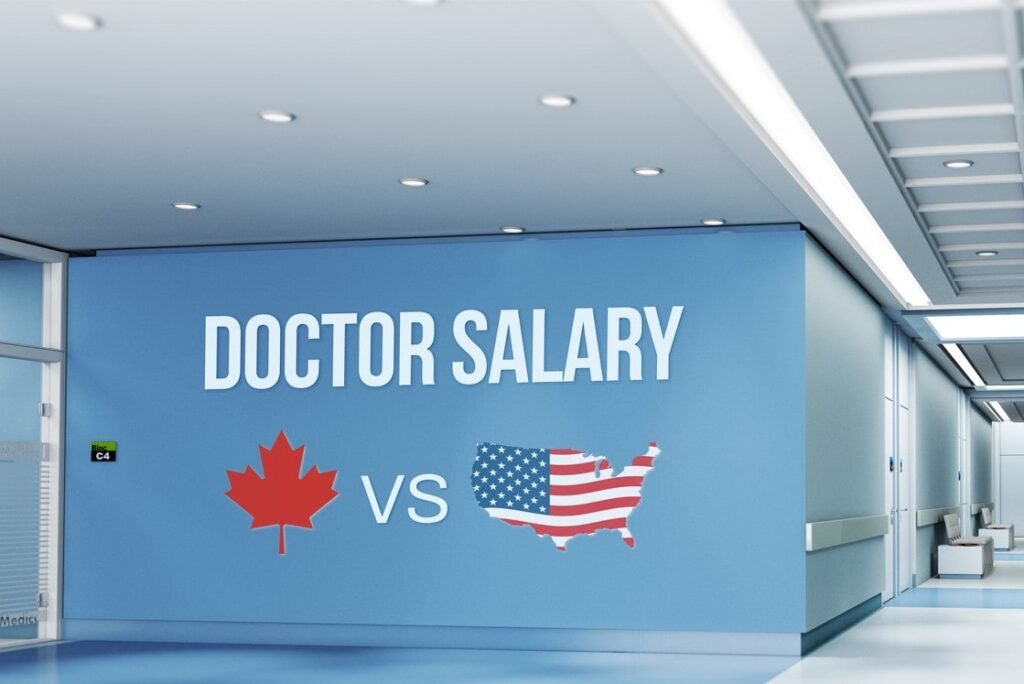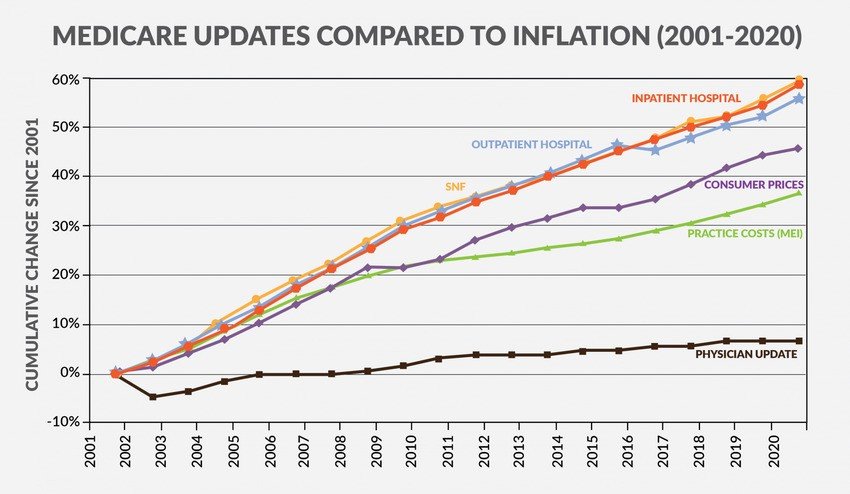Doctor Salaries in Canada vs USA | MCCQE1 Prep

Step onto any street corner, anywhere in North America. And ask a simple question. How much does a doctor earn in the United States compared to Canada? Without hesitation, without pause. The answer comes swiftly “Doctors in America make much more.”
It’s a widespread belief. One that reflects the general perception of economic opportunities in both countries. Many people think that doctors in the U.S. earn significantly more than their counterparts in Canada. We will explore this topic in more detail. As it is not entirely accurate.
In this post, I’m diving into the realities that many medical graduates face. When deciding where to build their careers; Canada or the USA. We’ll break down and compare doctor salaries across both countries to give you a clear picture of what to expect financially. Then, I’ll highlight how critical the MCCQE1 exam is for your career progression here in Canada. And share how Ace QBank can be a game changer in helping you pass this important test.
Comparing Canada vs USA Doctor Salaries
Imagine you have just finished medical school and you’re at a crossroads. Should you practice in Canada. Your home turf or venture south to the USA for potentially greener pastures?
One of the biggest factors in this decision is salary. And when you hear about doctor salaries. The US often looms large with figures that can make your eyes water. Of course, Canada holds its own. Offering a robust and rewarding environment for physicians.
But the key is understanding the nuances. Let’s break it down with the latest data and insights. so, you can make an informed choice.
In the USA, physicians are among the highest paid professionals globally. And the numbers reflect that the average annual salary for a physician in the USA hovers around $313,000.
With specialists often earning upwards of $400,000 or more depending on their field. Surgeons and anesthesiologists for instance; can rake in close to half a million annually. These figures come from robust data collected by organizations like Medscape. Which surveys thousands of doctors each year.
But here’s the kicker. These high salaries often come with a trade-off and the risk of burnout is on the rise. You’re not just earning a lot. You are also paying a significant price to get there.
Now, let’s cross the border to Canada. Here, the average physician earns about CAD $281,000 per year. With family doctors pulling in around CAD $200,000 and specialists closer to CAD $350,000.
These numbers, sourced from the Canadian Institute for Health Information (CIHI). Show a respectable income. But it’s notably lower than the USA’s figures. Even when adjusted for currency differences.
Why the gap? Canada operates under a publicly funded healthcare system. Which means physician fees are often regulated by provincial governments. While this caps earning potential. It also provides a level of stability.
Your income isn’t as tied to the whims of private insurance or patient volume as it is in the USA. But salary isn’t just about the paycheck. It’s about what you take home after taxes and expenses.
In the United States, rising earnings often come at a hidden cost. One which remains largely obscured from public view. Today, I want to shine a light on several of those unseen expenses. Steadily eroding a physician’s pay cheque.
Hidden Cost of Practicing Medicine | |
Hidden Cost | How It Impacts Salary |
CMS Fee Schedule Cuts | Directly lowers reimbursement rates, especially for Medicare-heavy practices. (3.34% cut for 2024; private insurers often follow Medicare’s lead.) |
Inflation (Real vs. Nominal Income) | Nominal salary may rise, but real income can stagnate or fall. (Physician pay is rising more slowly than hospital reimbursement; the cost of living increases outpacing wage growth.) |
Shifting Payment Models | Adds complexity and often favours institutions that can handle administrative demands. (Shift from FFS → RVU → VBC/APM) |
Administrative Burden | More unpaid time on paperwork, reporting and compliance. Reduces effective hourly wage (no extra pay for these tasks). |
Administrative Overhead | High system costs (billing, insurance processes) eat into what could be provider compensation. |
Workload & Burnout | To maintain income, doctors see more patients & add mid-level providers. This increases cost and burnout. |
First, consider what many refer to as the Squeeze of Reimbursement. The Centers for Medicare & Medicaid Services (CMS). They set the Physician Fee Schedule. A critical benchmark that guides payments across the industry.
For 2024, CMS enacted a stark 3.34% reduction in fees. This is no small matter. Because Medicare rates frequently establish the floor for private insurers. Cuts like these cascade downwards, tightening the financial noose around countless doctors. Especially those with a significant Medicare patient load.

Next comes a paradox. More patients but at higher operating costs. To compensate for dwindling reimbursement per service. Medical practices push to increase patient throughput. For that they need to employ more Physician Assistants and Nurse Practitioners.
Yet none of these strategies bear zero cost. Hiring additional personnel inevitably inflates overhead expenses. Chipping away further at physicians’ take-home pay.
Last but not least. The efficiency inside the doctor’s office matters deeply. When staff lack proper organization or office space. They simply cannot accommodate growing patient numbers.
Workloads spiral out of control. This environment fuels exhaustion and burnout. A troubling epidemic is now gripping healthcare’s frontline warriors.
So, those high American doctors salaries that you see on websites. Does not include the true cost and expenses. Costs are visible only when you look beyond the surface.
Plus, American doctors face significant malpractice insurance premiums. More on that in a moment.
In Canada, the tax burden is heavier due to progressive taxation rates. But the cost of living can be more manageable. Especially outside major hubs like Toronto or Vancouver.
And here’s a perk. Canadian doctors often enjoy better work-life balance thanks to regulated hours. And fewer administrative burdens compared to their American counterparts.
Expert insight backs this up. Dr. Jane Philpott. She is a Canadian physician and former Minister of Health. She has noted that while Canadian doctors may earn less on paper. The universal healthcare system reduces financial uncertainty and allows for a focus on patient care over profit.
On the flip side, American doctors like Dr. Atul Gawande have written extensively about how the USA’s fee for service model incentivizes higher earnings. But also drives up stress and overwork. It’s a trade off you will need to weigh as you map out your career.
What Is the Role of Insurance in Doctor Salaries?

Let’s zoom in on a critical piece of the financial puzzle for American doctors – Malpractice Insurance. In the USA, the healthcare system is largely privatized. Which means doctors are often on the hook for protecting themselves against lawsuits.
Malpractice insurance costs can be very high. Ranging from $10,000 to $100,000 annually depending on specialty. High risk fields like obstetrics or neurosurgery face the steepest costs. Especially in litigious states like Florida or New York.
If the physician bears the weight of prior insurance claims. Those numbers we discussed earlier? They become little more than a punchline. An ironic reminder that statistics alone can never capture the true complexity behind each case.
Moreover, there is a lack of a universal healthcare system. This means that American doctors often deal with complex billing and insurance claims. This adds to administrative costs and stress.
Many physicians hire staff just to navigate the labyrinth of private insurance companies. Cutting into their net income. It is a stark contrast to Canada. And it’s no wonder that a 2022 survey by the American Medical Association. Found that over 60% of US physicians report burnout tied to systemic issues like these.

Now, let’s pivot to Canada. Where the landscape looks very different. Thanks to the universal healthcare system under the Canada Health Act.
Physicians don’t face the same malpractice insurance burdens as their American peers. The Canadian Medical Protective Association (CMPA) provides liability coverage. And while doctors pay fees for this protection. They’re heavily subsidized by provincial governments.
For most Canadian doctors. Annual CMPA fees range from CAD $2,000 to $5,000. A fraction of what US doctors shell out. This government support means you’re not constantly looking over your shoulder for lawsuits. This allows you to focus on what matters, your patients.
Additionally, Canadian physicians benefit from government-negotiated fee schedules. Ensuring a steady income without the volatility of private insurance reimbursements.
While this caps earning potential as we discussed earlier. It also offers security. During the COVID-19 pandemic for example; many Canadian provinces provided additional funding and support to physicians to maintain services.
A safety net that is not universally available in the USA.
Government Support and Insurance Costs for Canadian Physicians

When it comes to understanding government support and the insurance landscape for Canadian physicians. I need to shed some light on the vital details.
More importantly, if you’re contemplating practicing medicine in Canada. This is the nitty-gritty you need to know to feel confident about what lies ahead.
Canada’s healthcare system is shaped by its structure. Support mechanisms and the way they handle malpractice protection through institutions. Institutions like the CMPA, which stands for Canadian Medical Protective Association.
What is CMPA, and Why is it Important?
The CMPA is a pivotal organization for physicians in Canada. Essentially, it’s a not for profit organization. That provides medical liability protection and assistance to doctors across the country. Membership isn’t just a recommendation—it’s practically essential for practicing physicians. Here’s why:
- Comprehensive Legal Defense and Protection
- Lower Costs Compared to the U.S.
When legal storm clouds gather over your medical practice. The CMPA is the ally you can count on while facing lawsuits or disputes related to care. But the CMPA steps in with a robust defence that means you’re never left to fight alone.
Their commitment is clear. Protect Canadian physicians with unmatched legal expertise and support.
Here in Canada, most doctors are CMPA members. And their fees (often subsidized or reimbursed by provinces) cover these critical services.
That means if a patient receives compensation due to medical negligence. The CMPA often facilitates these payments. That said, membership fees run between $3,000 and $20,000 CAD.
Ensuring physicians are protected from personal financial ruin. Put simply, the CMPA offers comprehensive legal defence and protection while keeping costs manageable. A true lifeline for Canadian doctors navigating the complex world of medical liability.

On the other hand, in the U.S., malpractice insurance can be very expensive for doctors, ranging from $50,000 to $200,000 a year. The cost varies by specialty and location. Depending on specialty and location.
Compared to Canada, where CMPA membership fees are a fraction of the cost. This is a significant difference in the cost. That means you receive top-notch protection without the financial stress.
This blend of government-backed stability. Affordable insurance through CMPA and comprehensive protections. Creates an environment where you can focus on patient care. Without the looming fear of financial or legal devastation.
As you prepare for your MCCQE part 1 exam. Know that Canada’s healthcare system is built to support your passion and purpose.
How Crucial is the Role of the MCCQE1 Exam in Career Progression?

The MCCQE part 1 is one of the requirements for medical graduates aspiring to secure rewarding careers in Canada. It’s more than just a rite of passage. It is a determinant of professional trajectory.
As a computerized standard test taken by medical graduates upon their completion of medical education school. The MCCQE Part 1 assesses fundamental competencies. Blending medical knowledge with clinical decision making. These are not just checkboxes to tick. They are the backbone of quality healthcare delivery.
For Canadian medical graduates (CMGs) and international medical graduates (IMGs) alike. This exam has far reaching implications.
A high MCCQE1 score can significantly boost your residency application to Canadian residency programs. Making it easier to match with top-tier training institutions. Conversely, a low score may limit your options. In fact, residency match statistics show a stark contrast between CMGs and IMGs.
While CMGs boast an impressive 97.7% match rate. IMGs face a daunting 22.6% match rate. Highlighting the steep climb for international graduates.
Beyond the residency match. The exam serves as a gateway to licensure in many provinces. It not only validates your clinical competence. But it also instills confidence in your ability to integrate into Canada’s healthcare system.
Ensuring you meet national standards. This exam is more than a hurdle. It’s a reflection of your readiness to deliver quality care.
Perhaps one of the most compelling aspects of the MCCQE1 is its role in differentiating candidates. According to reports, first-time IMG pass rates hover between 62% and 85% depending on the year. Underscoring the importance of extensive preparation.
Success here signals a blend of diligence, discipline and knowledge. Qualities that residency programs prize.
So, if you’re gearing up for the MCCQE1. Know that it is a linchpin in your medical career progression. And you need to leverage every resource at your disposal to conquer this exam with confidence.
Coming up next, we’ll explore the best Canadian question bank for MCCQE1 preparation. The platform that can help you prepare strategically and effectively.
Leverage Ace QBank for MCCQE1 Success

When it comes to excelling in the MCCQE1 exam. Preparation isn’t just key, it is everything. This exam assesses not only your medical knowledge. But also your clinical decision-making skills. A cornerstone for every successful doctor in Canada.
So, where should you turn to build that confidence and precision? The answer is crystal clear, Ace QBank.
Widely regarded as the best Canadian question bank for MCCQE1 preparation. The Qbank has established itself as an essential resource for future Canadian physicians. And I’m here to tell you why it’s your ultimate ally.
First off, what makes Ace QBank the leader in MCCQE1 exam prep? It starts with its core design. Every question in the bank is purpose-built. Striking a balance between being high-yield and uniquely Canadian.
They align precisely with the objectives outlined by the Medical Council of Canada. Make sure you are studying the content that matters most. That means you’re not only tackling practice questions. But mastering the very framework that underpins the MCCQE1 exam.
Did I mention that it’s designed to mirror the exact style and difficulty level of the exam? No? Well, it is. This feature can help you prepare effectively and build confidence before taking the exam.
But the platform doesn’t stop at just covering the basics. It’s built by Canadian physicians who understand the nuances of our healthcare system. And the challenges medical grads face when preparing for the exam.
Their expertise ensures the platform is loaded with evidence-based medicine explanations. The latest Canadian guidelines and recommendations. This means you’re not only getting ready for the exam. But also building a foundation to excel in clinical practice within Canada’s healthcare environment.
And this commitment to relevance and accuracy is what makes Ace QBank even more indispensable.
So, leveraging the Qbank for MCCQE1 exam prep. It is more than just practicing questions; it’s an active strategy. The platform’s structure encourages you to identify weak areas early and focus your study efforts efficiently.
That targeted approach allows for steady progress and boosts your confidence step by step. And let’s not forget the convenience. Online access to the platform makes it easier to fit high-quality exam preparation into even the most hectic of days.
At the end of the day, using Ace QBank isn’t just smart; it’s a no-brainer. Designed by physicians, tailored to the exam and brimming with features to facilitate your MCCQE1 exam preparation. All in all, consider the Qbank your ultimate ally in achieving success on your exam.
Top 4 Reasons to Use Ace QBank for Your MCCQE1 Exam Prep

When it comes to conquering the MCCQE part 1 exam. There is no room for shortcuts or half-hearted efforts. This exam is critical in cementing your future as a licensed physician in Canada. And the right preparation resource can make all the difference.
That’s where the Qbank comes in. A powerful question bank explicitly designed with future Canadian doctors in mind. Let’s break down the Top 4 Reasons why Ace QBank is the ultimate choice for your MCCQE1 exam prep.
- 2800 High-Yield Questions:
The Qbank offers a robust collection of 2800 high-yield questions. These aren’t just any questions. They are crafted to match the exact difficulty and style of the MCCQE1 exam.
The magic here lies in the MCCQE-style design of the questions. They align directly with the objectives set by the Medical Council of Canada. Each question is tailored to reflect the unique objectives set by the MCC.
Ensuring you’re not just reviewing random medical facts. But targeting the exact areas the MCC expects competent physicians to excel in.
The emphasis on clinical decision-making through problem-solving scenarios mirrors the real exam. Equipping you to think on your feet during test day. You are not just preparing; you are rehearsing for victory.
- Comprehensive Coverage of MCC Objectives:
One of the most daunting aspects of the MCCQE1 is its sheer scope. The exam demands mastery of virtually every corner of medicine. From diagnosing rare conditions to understanding public health policies.
The question bank makes sure you’ll confront this challenge head-on by providing comprehensive coverage of all MCC objectives.
The platform is designed to leave no stone unturned. That’s why there are 21 categories within your dashboard. Whether you’re reviewing internal medicine, pediatrics, psychiatry or any other subject area.
The question bank helps you cover it properly. By facilitating the question block creation in either the timed or tutor modes.
- Self-Assessment for MCCQE1:
Preparation is only half the journey. Assessing your progress is equally critical. This is where self-assessment features come into play.
The best part about the self-assessment questions is that they are distinct. And questions are designed to simulate the actual exam. This separation means you’re not simply recycling familiar content. You’re genuinely testing your readiness.
The simulations replicate the structure, timing and complexity of the real exam. Allowing you to experience the pressures and challenges you’ll face on test day.
This realistic environment helps you to achieve a couple of things. First, practicing under exam-like conditions. It allows you to put your time management skills to the test. Second, it helps you identify areas of weakness. So, you can fine-tune your preparation strategy.
- Unique Features for Robust Recall:
Great preparation hinges on retention. And the Qbank takes this to the next level with its innovative features.
The platform incorporates flowcharts, summary tables and custom illustrations. All are designed to simplify and enhance your recall of complex concepts.
Flowcharts are particularly helpful for visualizing diagnostic pathways and treatment algorithms. If you’ve ever felt overwhelmed by navigating clinical workflows. The Qbank’s flowcharts make these processes intuitive and memorable.
Likewise, summary tables distill voluminous information. Like risk factors, differential diagnoses or drug interactions. All into concise, bite-sized formats that are easy to digest.
On the other hand, custom illustrations provide clarity for topics that are better understood visually. These tools don’t just make learning easier. They make it stick.
Try Free MCCQE Part 1 Sample Questions

For those who are serious about passing the MCCQE Part 1 exam. You owe it to yourself to try out sample questions before you pay for any resource. Think of it as test-driving a car before you buy. It just makes sense.
Most reputable platforms, including Ace QBank. Offer free MCCQE Part 1 Sample Questions when you sign up for a demo account.
This isn’t some watered-down teaser. You get a real taste of what the full question bank offers. Including access to the actual interface. And the study features that matter most on exam day.
Here’s what I recommend:
- Sign up for a free demo.
- Experiment with creating question blocks.
- Try out different study modes.
These free sample questions are more than just a sneak peek. They are a smart way to see if the platform matches your needs before you invest. The bottom line is that you will find the Qbank. One that can truly support your journey toward licensure in Canada.
Is the Average Doctor Salary Higher in the US or Canada?

When it comes to deciding between practicing medicine in Canada or the United States, one question inevitably comes up. Where do doctors make more money?
At first glance, the United States seems to offer higher earning potential. But as with everything in medicine, the devil is in the details.
When we look at average doctor salaries. The USA often garners attention with its tantalizing paychecks. Top US physicians can rake in hundreds of thousands. Even millions annually depending on their specialty and location.
It is just fair to mention. The higher physician salaries in the USA. Come with significant financial and emotional challenges. Including expensive malpractice insurance, high student debt and administrative burdens.
By comparison, Canada’s average physician income. Sitting around CAD $200,000 annually might seem moderate. Even Canada’s specialist salaries. Which typically range between CAD $287,000 to $487,000 appear conservative next to the stratospheric peaks possible in the US.
That said, Canada provides a more stable healthcare environment with lower malpractice costs. A publicly funded system and diverse income opportunities. Through collaborative practice models and government support.
However, as any seasoned physician will tell you. It’s not just about the raw numbers. The financial realities of medical practice are shaped by a constellation of factors. Including insurance costs, debt, taxes and the systemic support around you.
What’s the Verdict?
While US physicians have the potential for higher earnings. This comes at the cost of significantly higher insurance premiums. Overwhelming debt and an often stressful healthcare system.
On the other hand, Canada offers a more stable financial pathway for doctors. With lower insurance costs. Strong government support and diverse career-building opportunities. Canadian doctors enjoy a balanced, rewarding career.
At the end of the day. While it’s true that the USA boasts higher average doctor salaries on paper. Canadian physicians often come out ahead. When you consider lower operational costs and the stability of the system.
Plus, with top Canadian specialties earning up to CAD $870,000 annually. The earning potential in Canada is more competitive than many assume.
As you gear up for your MCCQE1 and map out your future. Think not just about salary figures but the values and lifestyle you want as a practicing physician.
And if you do opt for Canada. You can rest easy knowing that strong government backing and smart practice strategies. Will let you earn, thrive and make a difference. Yes, doctors truly make more in Canada.
Key Takeaways
U.S. doctors Earn More on Paper but at Higher Costs. Physicians in the USA generally have higher average salaries compared to Canadian doctors. However, US doctors face significant hidden expenses. Such as very high malpractice insurance premiums, large student debt and high administrative costs, which reduce their net income.
Healthcare Systems Shape Financial Realities and Work-Life Balance. The US has a mostly privatized healthcare system with fee-for-service models that encourage higher earnings. But it also causes physician burnout and financial instability. In contrast, Canada’s publicly funded system reduces administrative tasks and promotes better work-life balance.
The MCCQE1 Exam Is Critical for Medical Career Progression in Canada. Passing the exam is one of the essentials for licensure and residency placement in Canada. Success on this exam significantly affects residency match rates. Especially for international medical graduates (IMGs).
Ace QBank Is a Highly Recommended Qbank for MCCQE1 Preparation. It provides 2800 MCCQE1-style. High-yield questions that align with the Medical Council of Canada objectives. Mimicking the exam’s format and difficulty. It offers realistic self-assessments and unique learning aids. Such as flowcharts and illustrations, to boost retention and exam readiness.


